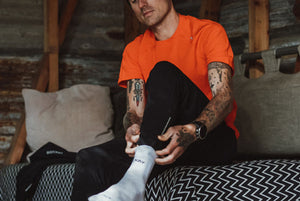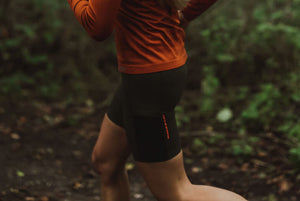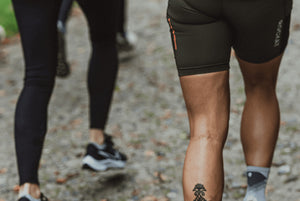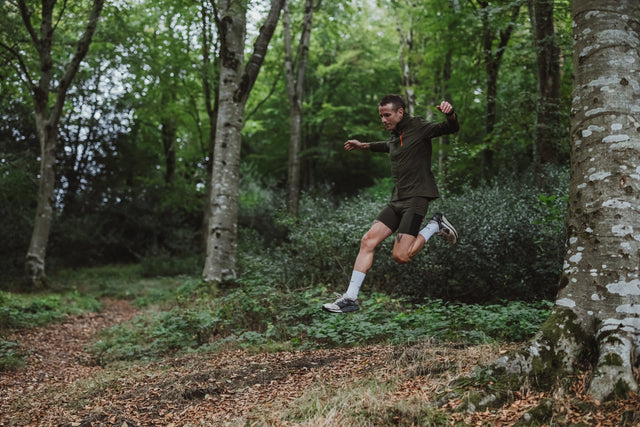You’re running along, doing your thing, and suddenly there it is: ankle pain. Why does my ankle hurt? Is it safe to keep running? How do I know when I need to stop and when it’s safe to continue? Can I fix it myself, or do I need to see a doctor? So many excellent questions!
Did you know that the average runner moving along at an eight-minute mile pace takes roughly 1,400 steps per mile? With each one of those steps, your ankle is helping to stabilize your body as your feet repeatedly pound the pavement.
Ankle Pain: What Causes It?
Ankle Sprain – If you twisted or turned your ankle the wrong way, or accidentally stepped down on something calling an ankle roll, you likely have a sprained ankle. Trail runners, in particular, are susceptible to ankle injuries due to the uneven terrain on which they are running.
Treatment for an ankle strain or sprain is explained through the acronym RICE. Rice stands for rest, ice, compression, and elevation.
"Rest the ankle to promote healing. Use ice, but for no more than twenty minutes at a time. Compress the area for support and again, to promote healing. Elevate the foot and ankle, keeping it above your heart. Also, you can take ibuprofen to reduce inflammation."
The old school method of treatment had athletes staying off of ankle sprains and using crutches for quite some time. New wisdom states that after the initial 24 hours, movement of the ankle is actually good. Athletic trainers will usually have the athlete doing ankle exercises and stretches as early as a day post-injury. Start by writing out the alphabet with your toe, rotating the ankle to “write” the letters.
When returning to activity, take it slow. You may also want support for the ankle post-injury. Most pharmacies sell ankle braces to help with this. Braces offer various levels of support, from an elastic wrap that has light support to a lace-up brace offering firm support.
Flat Feet Needing Arch Supports
If you are relatively new to running and suddenly your feet and ankles start to hurt, you may have flat feet. This is a fairly easy fix as some people’s problems can be taken care of by purchasing some arch support inserts. Over the counter arch supports are enough for some athletes, while others find a need for custom orthotics made by a podiatrist.
One thing for certain is that you should not let the ankle or foot pain go on for an extended period of time prior to seeking advice. The longer you let a problem linger on, the longer your recovery time may be.

Achilles Tendinitis
The Achilles is a band of fibrous tissue that connects your heel bone to the calf muscle. A problem with your Achilles could rear its ugly head through pain in the ankle, back of the leg down below the calf, or radiating through the foot. Tendinitis is actually micro-tears through this tissue.
You will notice that anti-inflammatory drugs will ease the discomfort, but rest is the best solution for tendinitis. As with other injuries, there are stretches and exercises to strengthen this area to prevent further problems.
Chronic Lateral Ankle Pain
This is the terminology used to describe pain brought about by an injury that did not heal properly. This is why finding ways to strengthen muscles and tendons surrounding the ankle is so important post-injury.
✓ Bursitis
If you have a small, swollen area that actually feels to be filled with fluid, this is a bursa sac. This means the space between the tendon and the bone is inflamed from overuse. This injury is typically also treated with RICE and anti-inflammatory drugs. One way to prevent this is by wearing sensible shoes all the time, as proper footwear is a full-time job!
✓ Stress Fracture
Sometimes an athlete will experience a stress fracture in or around the ankle, causing radiating ankle pain. This can happen when the athlete quickly increases their running miles in a short period of time. A stress fracture needs special imagery to diagnose. It is often treated by putting the athlete into a boot to stabilize the injury while it heals.
When to Visit the Doctor
It is time to visit your doctor if:
- You cannot bear weight on the foot at all after two or three days.
- You can’t run after a week of rest.
- Your foot or ankle bruises to the point of pooling blood or a bruise that appears black.
- You have symptoms of infection (hot to touch, red).
- Your ankle has been injured before in a similar fashion.

Prevention
The single best way to deal with ankle pain is to stop it before it can occur. There is a multitude of exercises that can be done to help strengthen the ankle and muscles around the ankle.
Exercises for Ankle Stability
✓ Balancing
Balance: Start by standing on one leg for 30 seconds, then switch to the other leg. Work your way up to one minute on each leg. Balance and Catch: Standing on one leg, throw a ball back and forth to a partner. One Leg Mini-Squats: While standing on one leg, do a half squat. Try to increase the number of mini-squats you can do or try to squat deeper.
✓ Standing Calf Raises
Go up onto your toes to do calf raises. Start with ten on each leg and work your way up to twenty. Stand on a step and do the raises and drops to make it more challenging.
Towel Pulls: Use a towel to wrap around your barefoot, pulling the foot toward you. Standing Squat Jumps: Starting from a standing position, jump into a deep squat. Repeat. Hopping exercises can help strengthen ankles. Bounding: Bounding exercises are useful for strengthening ankles and calves.
Protect Those Ankles!
If you experience ankle pain, there are some things you can do to help stop things from getting any worse. Following RICE is usually a safe bet for most sports-related injuries. There are also exercises you can do at home to try to improve your ankle strength, which is a good way to prevent future or further injury.
Remember: your ankles take a lot of impact shock while running. If you don’t take care of them, you might find yourself sidelined.
To reduce the risk of injury, consider trying our Blaze calf sleeves or Ignite arm sleeves.
Sources: How To Deal With Ankle Pain While Running Why Your Ankle Hurts










